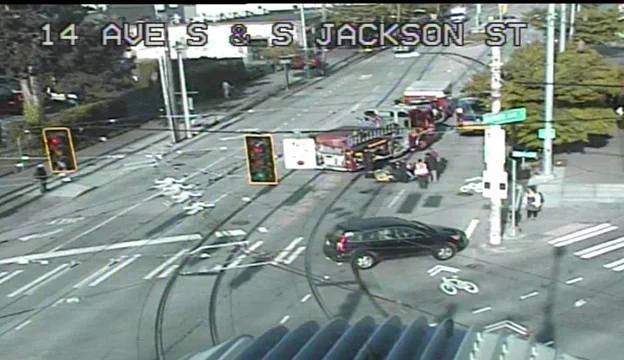Part 1: Seattle street cars and bicyclists

If you ride your bike anywhere in Seattle, you know about road hazards. Potholes, major elevation changes, and streetcar tracks are all bad news. These road hazards cause bicyclists to fall before they can do anything to stop it.
Aside from a stream of buses that often share bike paths, Seattle bicyclists must contend with drivers turning in front of them, drivers pulling into park in curb lanes, and maneuvering in spaces that don’t offer much separation from pedestrians. On top of this, Seattle bicyclists must avoid altogether or cross over streetcar and railroad tracks at the precisely correct angle. One might wonder how this is bike friendly. We do. We have for years and are constantly working to improve safety for everyone who travels these roads.
But the fact remains that Seattle roads with streetcar tracks create dangerous conditions for bicyclists and people who use wheelchairs, walkers, canes, or strollers.
Is this a new development? Not unless you consider something more than 10 years old “new”. Seattle Department of Transportation (SDOT) knew about this extreme danger as far at least as far back as 2007, years before it began construction of its First Hill Streetcar line. SDOT engineers, planners, and consultants emailed and discussed the issue they faced as the number of crashes and injuries grew resulting from bike tires getting trapped in streetcar tracks for the South Lake Union Trolley (SLUT… yes, that’s what we called it before “SLU Streetcar”) tracks.
By 2010 a number of bicyclists hired attorneys and sued the City of Seattle. These cases were consolidated (often done to streamline the court’s packed docket) and were set for trial in Seattle.
Fast forward a few years later. The attorneys for the injured bicyclists thought that the internal memos and emails from SDOT planners and engineers sufficed to establish the City’s negligence because the City had known that the tracks were dangerous. This is where the SLUT cases fell apart for the injured bicyclists.
In response to those attorneys’ argument, the City attorneys countered convincingly before King County Superior Court Judge McCarthy:
“We never disputed the tracks were a hazard,” said Rebecca Boatright, assistant city attorney who handled the case. “The legal question was whether we fell short of any engineering standard in designing a road with a streetcar.” (Seattle Times)
Judge McCarthy‘s ruling, dismissing the case, sent a chilling message: The City did nothing wrong and did not fall short of engineering standards despite its knowledge that placement of SLUT tracks on the curbside lane was dangerous for bicyclists. The dismissal of SLUT cases was a death knell for bike vs. streetcar tracks cases in Seattle. For over a decade, bicyclists who wanted to fight the City for injuries sustained because of streetcar tracks were out of luck, on their own with piles of medical bills and doctor’s visits for months or longer. No attorney was willing to take these types of cases. Bicyclists and road safety advocates knew that the dismissal of the SLUT cases was a huge setback for any other bicyclist who might want to sue the City for similar reasons.
Why did Judge McCarthy rule against the injured bicyclists who suffered only because of the unsafe road design around South Lake Union? We’ll discuss that in another blog post.
Thankfully, one attorney did not give up. Catherine Fleming advocated for years on behalf of bicyclists injured after streetcar tracks trapped their bike tires. Catherine’s hard work led a heightened recognition of the serious dangers that the City’s design created. She also obtained a record award, requiring the City to study and rethink modifications to improve safety in some of the most troublesome spots with streetcar tracks. She’s not done, though, and is more passionate than ever about advocating for safer streets, not just for her clients but for everyone.
Check back and learn more about the ongoing dangers that Seattle streetcars pose for bicyclists and pedestrians.
If you want to learn more about a different road safety issue in Seattle, let us know on Facebook, Instagram, or Twitter!

